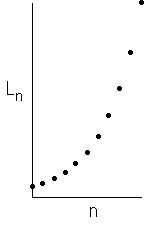|
 |
| length of a segment | number of segments | length of the curve | |
| L24 | 3.5(10-12) m | 281, 474, 976, 710, 656 | 1 km |
| L128 | 8.5(10-62) m | 115, 792, 089, 237, 316, 195, 423, 570, 985, 008, 687, 907, 853, 269, 984, 665, 640, 564, 039, 457, 584, 007, 913, 129, 639, 936 | 1 light year |